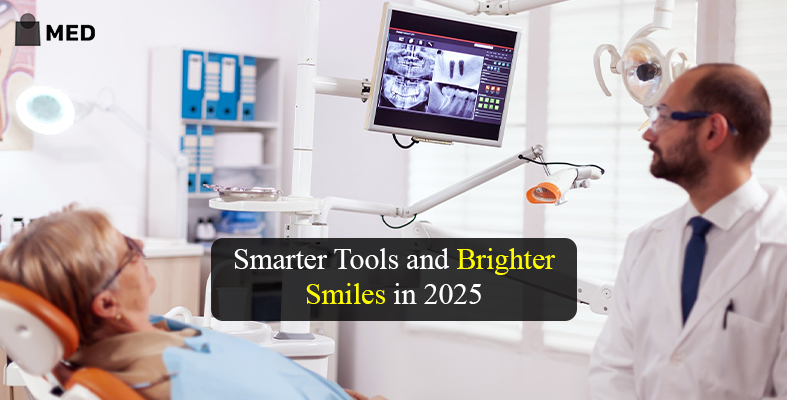TL;DR:
- Say goodbye to old-school brushing. Dental tech in 2025 is smarter, faster, and way more efficient.
- Expect more innovations like instant scans, 3D printed dental aligners, and AI-supported diagnostics.
- At home, smart toothbrushes, cordless flossers, and water flossers are helping people stay consistent with oral care.
- Whether at the dentist’s or in your bathroom, digital dentistry is changing how you care for your smile.
If you have visited a dentist recently, you may have noticed how much smoother and faster dental procedures are. Whether you are getting root canals, fillings, or aligners, tech in American dentistry has made the process more efficient. But this shift doesn’t stop at clinics.
At home, your daily routine is getting smarter too. From innovations like electric toothbrushes with real-time feedback or cordless water flossers that make cleaning feel effortless, every part of your oral care is improving. These innovations help you clean better; stick to habits, brush more consistently, and avoid issues before they develop.
This shift towards digital dentistry, from getting instant scans at the dentist’s office to smarter devices in your bathroom, is about helping you get better results with less effort. In this blog, we will explore what’s changing in American dentistry and dental tech innovations in 2025.
Modern Dental Procedures: What’s New and Why It Matters
Dental clinics in America are changing fast. As technology advances, treatments have become faster, more precise, and easier to handle, eliminating long wait times and multiple appointments. Here’s how the procedures are getting faster:
- Scans That Take Seconds: Dentists now use handheld intraoral scanners and digital X-rays that create a full image in seconds. It can help capture the entire mouth in 3D or instantly scan the patient’s mouth and spot the problems early, before they turn into bigger issues. These tools make diagnosis easier and more accurate.
- Get Crowns in One Visit: Once the scan is done, instead of sending molds to the lab and waiting for days for a crown or veneer, CAD/CAM (Computer-Aided Design/Computer-Aided Manufacturing) systems allow dentists to design and create them in the same clinic. In some cases, 3D printing is used to build temporary fittings on the spot. Since the design is based on detailed digital scans, the fit is more precise and reduces the need for adjustments later.
- Lasers Are Changing the Game: While restorations have become faster, many other treatments are becoming gentler. Dental lasers are used for procedures like filling cavities, reshaping gums, and root canals. They function with minimal contact, there’s often less pain, less bleeding, and faster healing. This tech upgrade is helping dentists treat more patients in less time while minimizing discomfort.
- Smarter Scheduling and Fewer Appointments: The shift towards digital dentistry isn’t limited to tools. Smarter workflows are also changing how appointments are managed. From virtual consultations to same-day planning and treatment, everything is becoming more connected. This reduces the number of visits needed and makes it easier for patients to fit oral care into their schedules.
- At-Home Dental Tech: It is not just clinics that are getting smarter; there are new tools that you can use at home for better dental hygiene. Tools like electric toothbrushes with sensors and real-time feedback, water flossers, mobile apps for customized guidance, and teledentistry platforms have made at-home oral care better. And you don’t have to spend a fortune to upgrade your routine. Check out the Oral-B discount codes that can make high-end oral care more accessible than ever.
Final Thoughts
Tech in American dentistry is transforming both professional treatments and personal routines. From digital scans that reduce time in the dentist’s office to smart brushes that make your daily routine more efficient, dental tech innovations are all about faster dental procedures and better results with less effort.
And if you want to upgrade your routine without overspending, don’t miss out on My Exclusive Deals for excellent offers on electric toothbrushes or other at-home dental tech. Take a moment to browse the latest offers, explore what’s trending, and grab a great deal to take the first step towards a brighter smile.
Also Read: Benefits of the Top Multivitamin Tablets for Skin, Hair, and Nails
FAQs
1. How is AI used in dentistry today?
AI tools are now helping dentists analyze X-rays and scans more accurately. This reduces human error and speeds up diagnosing issues like cavities or jaw misalignment.
2. How is 3D printing used for dental care?
Dentists use 3D printing to create crowns, bridges, and dentures more quickly. It allows for same-day fitting and more custom-fit restorations.
3. How does tech improve patient comfort during procedures?
Tools like no-drill lasers and quieter devices reduce pain and anxiety. These upgrades make visits more comfortable, especially for patients who are nervous about needles and other tools.
4. Can digital impressions replace digital molds?
Digital scanners can now capture detailed images of your teeth without messy molds. They offer greater accuracy for creating aligners, veneers, crowns, etc.
5. What is the role of robotics in dentistry?
Robotic-assisted systems help dentists perform complex procedures with high precision. This is especially useful in implant placement and minimally invasive surgeries.
6. Is teledentistry covered in insurance?
Some insurance companies in America now provide coverage for teledentistry for consultations and follow-ups. It is best to check your specific plan, as coverage may vary by state and service.
7. Do smart oral care devices really help prevent dental problems?
Devices like app-connected toothbrushes and sensors track brushing habits and help improve poor technique. They can prevent plaque buildup and other hygiene issues linked with poor oral care.
8. What are some new dental tech trends in 2025?
Some of these trends include the rise of Artificial Intelligence for diagnostics and treatment planning, real-time feedback by dental tools, personalized care apps, 3D printing, teledentistry, and robotics.
